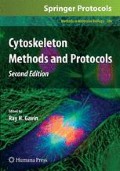Summary
The intermediate filament (IF) proteins have been recently found as dynamic structures that influence several aspects of cell homeostasis. Here, two alternative approaches to study the dynamics of IF proteins are described: the formation of cell hybrids by the fusion of different parental cells, and the transfection of keratin genes in cultured cells. In the first case, the selection of parental cell lines and the use of specific antibodies allow us to study how IF proteins recombine and copolymerize to form the heterokaryon cytoskeleton by immunofluorescence. In the second approach, some modifications of conventional transfection protocols allow the synchronized expression conditions, making it suitable for the analysis of the incorporation of a newly synthesized IF protein into the preexisting IF cytoskeleton of transfected cells.
Access this chapter
Tax calculation will be finalised at checkout
Purchases are for personal use only
References
Moll, R., Franke, W. W., Schiller, D. L., Geiger, B., and Krepler, R. (1982) The catalog of human cytokeratins: patterns of expression in normal epithelia, tumors and cultured cells Cell 31, 11–24.
Godsel, L. M., Hobbs, R. P., and Green, K. J. (2008) Intermediate filament assembly: dynamics to disease Trends Cell Biol 18, 28–37.
Hyder, C. L., Pallari, H. M., Kochin, V., and Eriksson, J. E. (2008) Providing cellular signposts-post-translational modifications of intermediate filaments FEBS Lett 582, 2140–2148.
Oshima, R. G. (2002) Apoptosis and keratin intermediate filaments Cell Death Differ 9, 486–492.
Paramio, J. M. and Jorcano, J. L. (2002) Beyond structure: do intermediate filaments modulate cell signalling? Bioessays 24, 836–844.
Eriksson, J. E., Opal, P., and Goldman, R. D. (1992) Intermediate filament dynamics Curr Opin Cell Biol 4, 99–104.
Joshi, H. C. (1998) Microtubule dynamics in living cells Curr Opin Cell Biol 10, 35–44.
Miller, R. K., Khuon, S., and Goldman, R. D. (1993) Dynamics of keratin assembly: exogenous type I keratin rapidly associates with type II keratin in vivo J Cell Biol 122, 123–135.
Lu, X., Quinlan, R. A., Steel, J. B., and Lane, E. B. (1993) Network incorporation of intermediate filament molecules differs between preexisting and newly assembling filaments. Exp Cell Res 208, 218–225.
Albers, K. and Fuchs, E. (1987) The expression of mutant epidermal keratin cDNAs transfected in simple epithelial and squamous cell carcinoma lines. J Cell Biol 105, 791–806.
Albers, K. and Fuchs, E. (1989) Expression of mutant keratin cDNAs in epithelial cells reveals possible mechanisms for initiation and assembly of intermediate filaments. J Cell Biol 108, 1477–1493.
Lu, X. and Lane, E. B. (1990) Retrovirus-mediated transgenic keratin expression in cultured fibroblasts: specific domain functions in keratin stabilization and filament formation. Cell 62, 681–696.
Paramio, J. M., Casanova, M. L., Alonso, A., and Jorcano, J. L. (1997) Keratin intermediate filament dynamics in cell heterokaryons reveals diverse behaviour of different keratins. J Cell Sci 110, 1099–111.
Paramio, J. M. and Jorcano, J. L. (1994) Assembly dynamics of epidermal keratins K1 and K10 in transfected cells. Exp Cell Res 215, 319–331.
Paramio, J. M. (1999) A role for phosphorylation in the dynamics of keratin intermediate filaments. Eur J Cell Biol 78, 33–43.
Acknowledgements
This work is partially supported by Grants: SAF2005–00033 (MEC), Oncocycle (S2006/BIO-0232 from CAM) and ISCIII-RETIC RD06/0020 (MSC) to JMP.
Author information
Authors and Affiliations
Editor information
Editors and Affiliations
Rights and permissions
Copyright information
© 2009 Humana Press, a part of Springer Science+Business Media, LLC
About this protocol
Cite this protocol
Paramio, J.M. (2009). The Analysis of Intermediate Filament Dynamics Using Transfections and Cell Fusions. In: Gavin, R. (eds) Cytoskeleton Methods and Protocols. Methods in Molecular Biology, vol 586. Humana Press. https://doi.org/10.1007/978-1-60761-376-3_20
Download citation
DOI: https://doi.org/10.1007/978-1-60761-376-3_20
Published:
Publisher Name: Humana Press
Print ISBN: 978-1-60761-375-6
Online ISBN: 978-1-60761-376-3
eBook Packages: Springer Protocols

